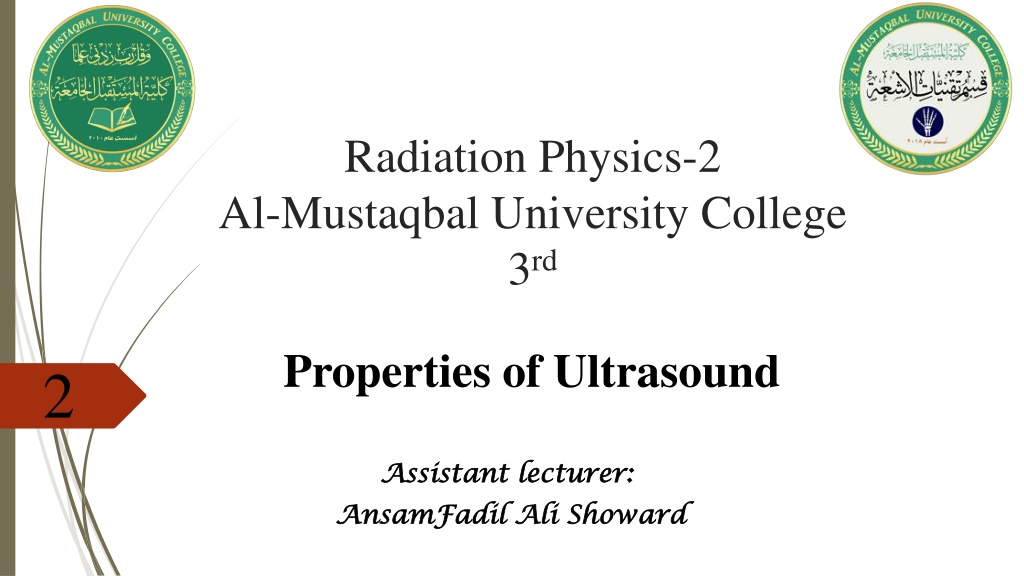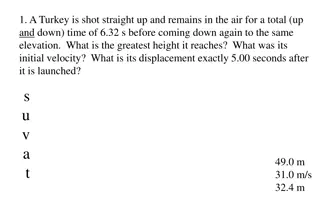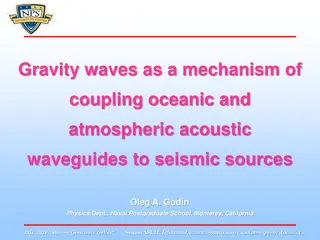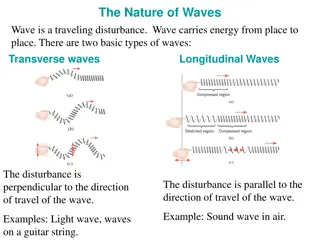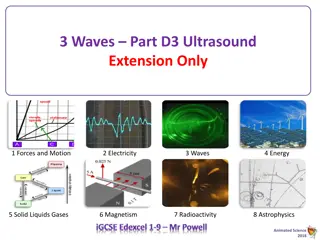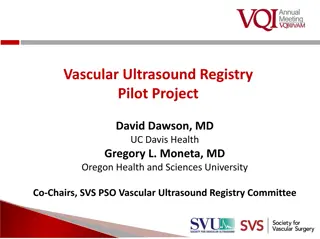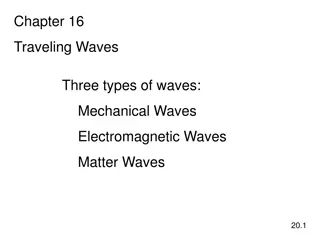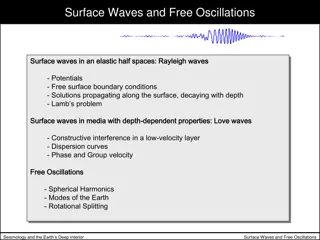Properties of Ultrasound: Waves and Velocities
Sound waves, including ultrasound, are pressure disturbances transmitted through matter as mechanical pressure waves. They propagate differently in fluids and solids, exhibiting both longitudinal and transverse waves. Understanding phase and group velocities in waves is essential for grasping the behavior of interference and dispersion in ultrasound.
Download Presentation

Please find below an Image/Link to download the presentation.
The content on the website is provided AS IS for your information and personal use only. It may not be sold, licensed, or shared on other websites without obtaining consent from the author.If you encounter any issues during the download, it is possible that the publisher has removed the file from their server.
You are allowed to download the files provided on this website for personal or commercial use, subject to the condition that they are used lawfully. All files are the property of their respective owners.
The content on the website is provided AS IS for your information and personal use only. It may not be sold, licensed, or shared on other websites without obtaining consent from the author.
E N D
Presentation Transcript
Radiation Physics-2 Al-Mustaqbal University College 3rd Properties of Ultrasound 2 Assistant lecturer: Assistant lecturer: AnsamFadil AnsamFadil Ali Ali Showard Showard
Properties of Ultrasound Sound is a pressure disturbance (vibration) transmitted through all forms of matter: gases, liquids, solids, and plasmas as mechanical pressure waves that carry kinetic energy. A medium must therefore be present for the propagation of these waves, since cannot travel through a vacuum Type of Waves Depends on the Medium Ultrasound and sound waves propagates in a fluid (gases and liquids) as longitudinal waves, in which the particles of the medium vibrate to and fro along the direction of propagation, alternately compressing and rarefying the material. In hard tissues like bone, ultrasound can be transmitted as both longitudinal (compression) and transverse (shear) waves; in the latter case, the particles move perpendicularly to the direction of propagation.
Phase Velocity and Group Velocity There are two different fundamental sound velocities we must distinguish between them: the group velocity and the phase velocity ** Waves can exhibit interference, which in extreme cases of constructive and destructive interference leads to complete addition (a) or complete cancellation (b) of the two waves.
Phase Velocity You could pick one particular phase of the wave (for example the crest) and it would appear to travel at the phase velocity. Phase velocity corresponds to the propagation velocity of a given phase that is of a single frequency (i.e. single mode) component of a periodic wave.
The phase velocity of a wave is the speed at which a given phase of a wave travels through space. The phase velocity of a wave is the rate at which the phase of the wave propagates in space. phase velocity is definedas This is the velocity at which the phase of any one frequency component of the wave will propagate. Phase velocity term generally comes into picture when there is a single wave, suppose in optical fiber when there is only one mode (i.e. single mode) then your phase velocity is defined and same as group velocity. A propagating medium is said to be dispersive if the phase velocity is a function of frequency or wavelength, which is the case for example in all attenuating media. This means that the different frequencies contained in the signal do not propagate at constant velocities.
Group Velocity The group velocity is the speed of the overall shape of a modulated wave (called the envelope). The group velocity of a wave is the rate that changes in amplitude (known as the envelope of the wave) will propagate through space. (The existence of different modes each has a different velocity). The group velocity vp is given by If the wave is travelling through a medium of absorptive, and this does not always hold. In the case of an absorptive medium, the group velocity may vary from the phase velocity. It is important to be aware of the speed of dispersion because it affects are likely to be accurate measurements of the speed of sound.
Wavelength and Speed of Propagation In soft tissue, the speed of sound is approximately 1540 m.s 1. In any medium, the velocity of an ultrasound wave through a medium varies with the physical properties of the medium. It is determined primarily by two properties of the medium (the density and compressibility); and to a lesser degree by the conditions of the medium such as ambient temperature and pressure. The speed of sound (c) is the distance that a point on a wave (such as a compression or a rarefaction) travelled during a unit of time by a sound wave propagating through an elastic medium. For example, in pure water, it is 1492 m/s (20 C). Note that the speed of sound in air depends only on the temperature. In low-density media such as air and other gases, molecules may move over relatively large distances before they influence neighboring molecules. In these media, the velocity of an ultrasound wave is relatively low. In solids, molecules are constrained in their motion, and the velocity of ultrasound is relatively high. Liquids exhibit ultrasound velocities intermediate between those in gases and solids.
The velocities of ultrasound in various media are listed in Table 1. Table 1: Approximate Velocities of Ultrasound in Selected Materials
As known from basic physics the characteristic variables describing the propagation of a monochromatic wave in time and space are frequency ( f ) or period (T) velocity (v) and wavelength ( ) are related to each other following: Note: Usually measured waves in the electromagnetic spectrum, such as radio waves and light waves, millimeters, or nm, instead of centimeters or meters. This is because it has much shorter wavelengths than the sound waves. is in The speed of sound c may be expressed in terms of K and thus Where is Density describes the mass of the medium per unit volume, and stiffness K is high for relatively incompressible media such as solids, but low for compressible media such as gases.
The wavelengths of ultrasound are closely related to ultrasound frequency, both influence the resolution of the images. Better resolution is associated with a higher ultrasound frequency, the shorter wavelength but absorption of the sound energy by tissue also increases with frequency. The resolution can determine the degree of image clarity. That meant the resolution is the ability of the ultrasound machine to distinguish two structures (reflectors or scatters) that are close together as separate. The kinetic energy of the sound waves is converted to heat (thermal energy) in the medium when sound waves are absorbed. The applications of ultrasound to bring heat or agitation into the body (thermotherapy) were the first use of ultrasound in medicine.
Diagnostic Ultrasound Today, ultrasound (US) is one of the most commonly used imaging technologies in medicine. Sounds in the range 2 and 18 megahertz (MHz) are typically used for diagnostic ultrasound. The accuracy of ultrasound diagnosis based on computerized analysis of reflected ultrasound waves, which non-invasively build up fine images of internal body structures. The best resolution can be achieved by using shorter wavelengths, with a wavelength that is inversely proportional to the frequency. However, the use of high frequencies is limited due to the increased attenuation (loss of signal so easily absorbed and thus shorter than the depth of penetration. reason, specific probes are used for different frequency ranges to examine different parts of the body: strength) in various tissues and For this
35 MHz for abdominal areas 5 10 MHz for small and superficial parts 10 30 MHz for the skin or the eyes Because of the heterogeneity of the different tissues within the body with different densities, the ultrasonic waves penetrate varies accordingly. Bones absorb ultrasound much more than soft tissue, so that, in general, ultrasound is suitable for examining only the surfaces of the bone. For this reason, ultrasound images show a black zone behind the bones due to the inability of ultrasound energy to reach those areas. If the high frequencies used, called acoustic shadow.
